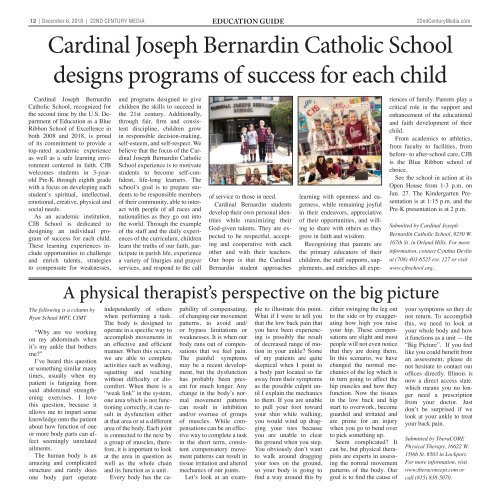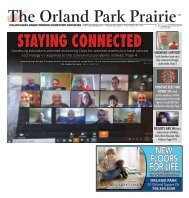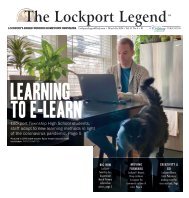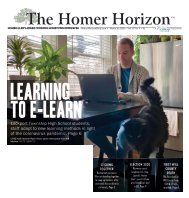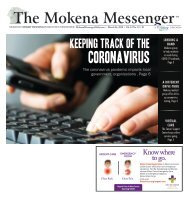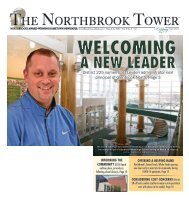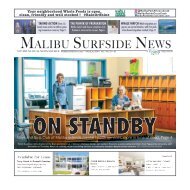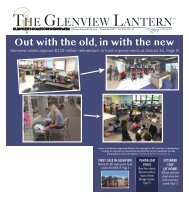Education Guide 120618 Zone A
Create successful ePaper yourself
Turn your PDF publications into a flip-book with our unique Google optimized e-Paper software.
12 | December 6, 2018 | 22nd century media education guide<br />
22ndCenturyMedia.com<br />
Cardinal Joseph Bernardin Catholic School<br />
designs programs of success for each child<br />
Cardinal Joseph Bernardin<br />
Catholic School, recognized for<br />
the second time by the U.S. Department<br />
of <strong>Education</strong> as a Blue<br />
Ribbon School of Excellence in<br />
both 2008 and 2018, is proud<br />
of its commitment to provide a<br />
top-rated academic experience<br />
as well as a safe learning environment<br />
centered in faith. CJB<br />
welcomes students in 3-yearold<br />
Pre-K through eighth grade<br />
with a focus on developing each<br />
student’s spiritual, intellectual,<br />
emotional, creative, physical and<br />
social needs.<br />
As an academic institution,<br />
CJB School is dedicated to<br />
designing an individual program<br />
of success for each child.<br />
These learning experiences include<br />
opportunities to challenge<br />
and enrich talents, strategies<br />
to compensate for weaknesses,<br />
and programs designed to give<br />
children the skills to succeed in<br />
the 21st century. Additionally,<br />
through fair, firm and consistent<br />
discipline, children grow<br />
in responsible decision-making,<br />
self-esteem, and self-respect. We<br />
believe that the focus of the Cardinal<br />
Joseph Bernardin Catholic<br />
School experience is to motivate<br />
students to become self-confident,<br />
life-long learners. The<br />
school’s goal is to prepare students<br />
to be responsible members<br />
of their community, able to interact<br />
with people of all races and<br />
nationalities as they go out into<br />
the world. Through the example<br />
of the staff and the daily experiences<br />
of the curriculum, children<br />
learn the truths of our faith, participate<br />
in parish life, experience<br />
a variety of liturgies and prayer<br />
services, and respond to the call<br />
of service to those in need.<br />
Cardinal Bernardin students<br />
develop their own personal identities<br />
while maximizing their<br />
God-given talents. They are expected<br />
to be respectful, accepting<br />
and cooperative with each<br />
other and with their teachers.<br />
Our hope is that the Cardinal<br />
Bernardin student approaches<br />
learning with openness and eagerness,<br />
while remaining joyful<br />
in their endeavors, appreciative<br />
of their opportunities, and willing<br />
to share with others as they<br />
grow in faith and wisdom.<br />
Recognizing that parents are<br />
the primary educators of their<br />
children, the staff supports, supplements,<br />
and enriches all experiences<br />
of family. Parents play a<br />
critical role in the support and<br />
enhancement of the educational<br />
and faith development of their<br />
child.<br />
From academics to athletics,<br />
from faculty to facilities, from<br />
before- to after-school care, CJB<br />
is the Blue Ribbon school of<br />
choice.<br />
See the school in action at its<br />
Open House from 1-3 p.m. on<br />
Jan. 27. The Kindergarten Presentation<br />
is at 1:15 p.m. and the<br />
Pre-K presentation is at 2 p.m.<br />
Submitted by Cardinal Joseph<br />
Bernardin Catholic School, 9250 W.<br />
167th St. in Orland Hills. For more<br />
information, contact Cynthia Devlin<br />
at (708) 403-6525 ext. 127 or visit<br />
www.cjbschool.org.<br />
The following is a column by<br />
Ryan Schaul MPT, CIMT<br />
A physical therapist’s perspective on the big picture<br />
“Why are we working<br />
on my abdominals when<br />
it’s my ankle that bothers<br />
me?”<br />
I’ve heard this question<br />
or something similar many<br />
times, usually when my<br />
patient is fatiguing from<br />
said abdominal strengthening<br />
exercises. I love<br />
this question, because it<br />
allows me to impart some<br />
knowledge onto the patient<br />
about how function of one<br />
or more body parts can affect<br />
seemingly unrelated<br />
ailments.<br />
The human body is an<br />
amazing and complicated<br />
structure and rarely does<br />
one body part operate<br />
independently of others<br />
when performing a task.<br />
The body is designed to<br />
operate in a specific way to<br />
accomplish movements in<br />
an effective and efficient<br />
manner. When this occurs,<br />
we are able to complete<br />
activities such as walking,<br />
squatting and reaching<br />
without difficulty or discomfort.<br />
When there is a<br />
“weak link” in the system,<br />
one area which is not functioning<br />
correctly, it can result<br />
in dysfunction either<br />
at that area or at a different<br />
area of the body. Each joint<br />
is connected to the next by<br />
a group of muscles, therefore,<br />
it is important to look<br />
at the area in question as<br />
well as the whole chain<br />
and its function as a unit.<br />
Every body has the capability<br />
of compensating,<br />
of changing our movement<br />
patterns, to avoid and/<br />
or bypass limitations or<br />
weaknesses. It is when our<br />
body runs out of compensations<br />
that we feel pain.<br />
The painful symptoms<br />
may be a recent development,<br />
but the dysfunction<br />
has probably been present<br />
for much longer. Any<br />
change in the body’s normal<br />
movement patterns<br />
can result in inhibition<br />
and/or overuse of groups<br />
of muscles. While compensations<br />
can be an effective<br />
way to complete a task<br />
in the short term, consistent<br />
compensatory movement<br />
patterns can result in<br />
tissue irritation and altered<br />
mechanics of our joints.<br />
Let’s look at an example<br />
to illustrate this point.<br />
What if I were to tell you<br />
that the low back pain that<br />
you have been experiencing<br />
is possibly the result<br />
of decreased range of motion<br />
in your ankle? Some<br />
of my patients are quite<br />
skeptical when I point to<br />
a body part located so far<br />
away from their symptoms<br />
as the possible culprit until<br />
I explain the mechanics<br />
to them. If you are unable<br />
to pull your foot toward<br />
your shin while walking,<br />
you would wind up dragging<br />
your toes because<br />
you are unable to clear<br />
the ground when you step.<br />
You obviously don’t want<br />
to walk around dragging<br />
your toes on the ground,<br />
so your body is going to<br />
find a way around this by<br />
either swinging the leg out<br />
to the side or by exaggerating<br />
how high you raise<br />
your hip. These compensations<br />
are slight and most<br />
people will not even notice<br />
that they are doing them.<br />
In this scenario, we have<br />
changed the normal mechanics<br />
of the leg which is<br />
in turn going to affect the<br />
hip muscles and how they<br />
function. Now the tissues<br />
in the low back and hip<br />
start to overwork, become<br />
guarded and irritated and<br />
are prime for an injury<br />
when you go to bend over<br />
to pick something up.<br />
Seem complicated? It<br />
can be, but physical therapists<br />
are experts in assessing<br />
the normal movement<br />
patterns of the body. Our<br />
goal is to find the cause of<br />
your symptoms so they do<br />
not return. To accomplish<br />
this, we need to look at<br />
your whole body and how<br />
it functions as a unit — the<br />
“Big Picture”. If you feel<br />
like you could benefit from<br />
an assessment, please do<br />
not hesitate to contact our<br />
offices directly. Illinois is<br />
now a direct access state,<br />
which means you no longer<br />
need a prescription<br />
from your doctor. Just<br />
don’t be surprised if we<br />
look at your ankle to treat<br />
your back pain.<br />
Submitted by TheraCORE<br />
Physical Therapy, 16622 W.<br />
159th St. #503 in Lockport.<br />
For more information, visit<br />
www.theraconcept.com or<br />
call (815) 838-5070.


